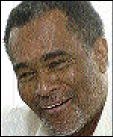
Dennis Morrison, Guest Columnist
The more vocal elements of the local private sector were highly critical of the hike in interest rates late last year by the Bank of Jamaica (BOJ), the fourth or fifth bout of sharp rate increases in the last 18 years.
Their concern was the obvious increased burden imposed on the costs of businesses and consumers' purchasing power.
As was the case in the last bout in 2003, the recent hike also brought into sharp focus how significantly interest rate movements affect the country's fiscal situation and the extent to which rate increases compound our debt problem.
It is now widely recognised that, this time, the added debt burden, if local interest rates were to remain high for an extended period, is fiscally unsustainable, given the sheer size of the national debt and the fact that local debt represents the greater share of the overall amount owed by the Jamaican Government.
The local debt of the public sector has also been increasing at a faster rate than revenues, and outstripping the rate of growth of the economy.
Whereas external debt represented three-quarters of the national debt in 1994 and, therefore, Government's interest payments were more sensitive to exchange rate risks than to movements in local interest rates, that situation was reversed by 2000 as the share of domestic debt overtook that of the external debt.
Powerful pressure
In fact, the ratio of domestic debt climbed steeply from 25.6 per cent of gross domestic product (GDP) in 1994 to 55.4 per cent by 2000, and from 29.2 per cent to 62 per cent, while the ratio of domestic interest payments increased from 68 per cent to 84 per cent of total interest payments in 2000.
By 2007, the ratio of domestic debt had risen to over 72 per cent of GDP, after reaching as high as 88 per cent in 2003 but, as local interest rates fell significantly, interest payments actually went down to 72 per cent of total interest payments, having risen to 81 per cent in 2003.
This happened even as the ratio of total debt to GDP increased modestly from 101.2 per cent in 1994 to 107.7 per cent in 2000 and to 110 per cent in 2008, after jumping to over 140 per cent in 2004.
While it is demonstrably clear that domestic interest rates exert powerful pressures on government's debt-servicing costs and the fiscal accounts - and there is now broad agreement on this - it is critical that there be also a greater understanding of the factors that determine these rates and how they can be ˆbrought down on a sustainable basis.
Since financial liberalisation began in the 1980s and exchange controls and price controls were removed in 1991, interest rates have been influenced by the rate of inflation and the conduct of monetary policy in pursuing price stability.
Associated with the objective of price stability has been the stabilisation of the foreign exchange market, in an economy that has serious structural weaknesses and is highly susceptible to external shocks as was evident in the food and oil price hikes in 2007 and 2008.
So, these are two key and related factors that have underpinned the direction of interest rates.
Government's fiscal accounts influence interest rate move-ments and, hence, deficits which necessitate demand for financing from local resources, and is yet another factor that fuels the upward movement of rates.
Negative reinforcement
I hasten to add that to the extent that interest rate hikes have, at various points, been driven by the objectives of controlling inflation and stabilising the foreign exchange market when the fiscal deficit was rising, only served to further aggravate the deficit and push up government borrowing.
Thus, we ended up with negative factors reinforcing each other in 2003 and, again, now.
Interest rates also move in response to expectations and overall confidence in the direction of the economy and to intangible factors, as well.
Certainty about policy direction and the capacity to sustain consistency in policymaking and implementation influence expectations and confidence significantly.
Over the past three decades, these have been major areas in which Jamaica's performance has been weak.
For the last 15 or more years, I have written and spoken extensively that interest rates are not an independent variable that the financial authorities in Jamaica can decree without regard for a number of economic fundamentals.
Indeed, not even the United States Federal Reserve Board, the world's most powerful central bank, can do so.
While there is no doubt that heavy public sector borrowing from the domestic market and monetary policy objectives have exerted powerful pressure on domestic interest rates, the issue is to understand the factors that determine interest rates and how these can be managed to bring them down on a sustainable basis and to keep them at internationally competitive levels.
business@gleanerjm.com
business@gleanerjm.com